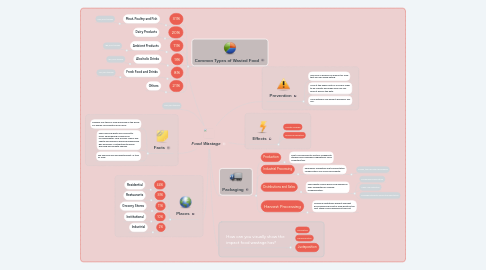
1. 340,000 tonnes
2. Places
2.1. 44%
2.1.1. Residential
2.2. 33%
2.2.1. Restaurants
2.3. 11%
2.3.1. Grocery Stores
2.4. 10%
2.4.1. Institutional
2.5. 2%
2.5.1. Industrial
3. Facts
3.1. Roughly one third of food produced in the world for human consumption every year.
3.2. Food loss and waste also amount to major squandering of resources, including water, land, energy, labour and capital and needless produce greenhouse gas emissions, contributing to global warming and climate change.
3.3. We annually lose and waste about 1.3 tons of food.
4. Common Types of Wasted Food
4.1. 31%
4.1.1. Meat, Poultry and Fish
4.1.1.1. 540,000 tonnes
4.2. 20%
4.2.1. Dairy Products
4.3. 11%
4.3.1. Ambient Products
4.3.1.1. 185,000 tonnes
4.4. 9%
4.4.1. Alcoholic Drinks
4.4.1.1. 150,000 tonnes
4.5. 8%
4.5.1. Fresh Food and Drinks
4.5.1.1. 140,000 tonnes
4.6. 21%
4.6.1. Others
5. Prevention
5.1. Only buy or prepare an amount of food that you can finish eating.
5.2. Look at the expiry date of a food in order to be realistic and make sure you can finish it before the date.
5.3. Save leftovers and finish it whenever you can.
6. Effects
6.1. Climate Change
6.2. Resource Depletion
7. Packaging
7.1. Production
7.1.1. Due to environmental factors, inadequate storage and compliance regulations, food is wasted/loss.
7.2. Industrial Processing
7.2.1. Packaging, marketing and transportation complications can cause food waste,
7.2.1.1. Tough, tear resistant packaging
7.3. Distributions and Sales
7.3.1. Food waste occurs when food demand is over-forecasted or ordered inappropriately.
7.3.1.1. Freshness preservation
7.3.1.2. Shelf-life extention
7.3.1.3. Package integrity during transportation
7.4. Harvest Processing
7.4.1. Technical limitations prevent efficient processing and result in food waste in the first stage of processing post harvest.
